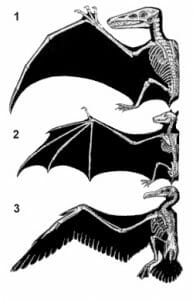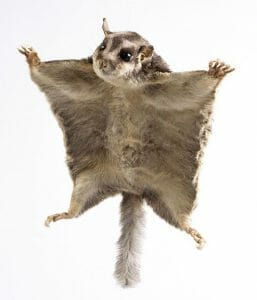Convergent Evolution Definition
Convergent evolution is the process in which organisms that are not closely related independently evolve similar features. Adaptions may take the form of similar body forms, colors, organs and other adaptions which make up the organism’s phenotype.
Convergent evolution creates analogous structures or ’homoplasies’, those which have similar forms or functions between diverged species, but were not present in the common ancestor of the two. On the other hand, homologous structures, i.e., a specific organ or bone which appears throughout many different organisms, albeit often in a slightly different form or shape, can indicate a divergence from a common ancestor.
There are several circumstances that can result in convergent evolution. Often, convergence occurs when organisms are required to adapt to similar environmental conditions, such as in the evolution of thick water-retaining leaves and spines on cacti and Euphorbia species, which are adapted to tolerate conditions of extreme drought but are native to separate continents. It may also occur when two different organisms occupy a similar niche, for example, the cryptic green coloration of Emerald Tree Boas (Corallus caninus) from South America and Green Tree Pythons (Chondropython viridis) from Australia, both of which live high up in the canopy of similar rainforests and occupy a niche predating upon birds.
Convergence of life cycle and behavioral traits, such as the similar social colony structures between Naked Mole-rats (Heterocephalus glaber) and many species of social bees and ants, can also take place in order to maximize breeding success of individuals and within colonies. On a molecular level, the independent evolution of proteins and toxins has also occurred throughout many separate phyla; for example, sea anemones (Cnidaria), snakes (Vertebrates), scorpions (Arthropods) and cone snails (Molluscs) all produce neurotoxins which act similarly upon the neurotransmitter receptors of their prey.
Convergent evolution can also arise through mimicry complexes, in which organisms evolve to replicate the morphology of other species. This adaption benefits the mimic either by way of protection when imitating the phenotype of an organism that is toxic or otherwise dangerous (Batesian mimicry), or allowing the mimic to exploit a resource or interaction by being mistaken for the model (Müllerian mimicry).
The process of convergent evolution is in contrast to divergent evolution, whereby species which are closely related evolve different traits, and parallel evolution, in which similar traits develop in related, although distinct, species from a common ancestor but from different clades.
Examples of Convergent Evolution
Convergent Evolution of Wings
A widespread example of convergent evolution is the evolution of wings and powered flight in birds, bats and (now extinct) pterosaurs, each of which belong to a different class of organism and therefore have very distant common ancestors.
Fossil evidence has determined that flight evolved in pterosaurs (flying reptiles of the late Triassic period) around 225mya and in birds around 150mya, while mammalian bats evolved wings around 50-60mya. The evolution of powered flight has only happened once in each of these lineages, although there are certain organisms, for example, ostrich birds, which have subsequently reverted back to being flightless while retaining their wing structures.
The different wing structures of birds, bats and pterosaurs are each supported by a modified five-fingered limb. Each limb consists of a humerus a radius and ulna, a thumb and finger bones, and is a homologous structure, containing the same bones that make up the limbs of many animals including humans, whales and crocodiles; however, the shape of each bone differs greatly between each form.
An elongated fourth finger shapes the pterosaur wing, with the other digits used as claws. In birds, an elongated radius and ulna, as well as finger bones fused together for strength, support the wing. Finally, the wings of a bat differ in that they are formed of membrane that is stretched over four elongated fingers. The reason each of these different bone formations results in the same eventual wing shape is due to the basic physics of flight: wings that were shaped much differently would not allow an animal to fly.
Although birds and pterosaurs share a very distant common ancestor, and birds also share a common ancestor with bats, none of these ancestors had wings or were able to fly. In each of these lineages, the wing is therefore an analogous structure because the bones have been arranged differently in order to independently achieve a functionally similar structure.
The image above shows the different internal bone structures of wings in: 1) Reptilian pterosaurs (Pterosauria). 2) Mammalian bats (Chiroptera). 3) Birds (Aves).
Convergent Evolution between Placental Mammals and Marsupials
Placental mammals, which have offspring that undergo gestation within the uterus and are born fairly advanced, and marsupials whose offspring are born very immature and continue to develop within a pouch on the mother’s body, diverged from a common ancestor around 100 million years ago.
Separated by the split of continents, mammals evolved to occupy niches in Europe, Africa and America, while marsupials occupied similar niches in Australia and the surrounding islands; this history has produced many examples of convergent evolution.
Animals from each group developed similar analogous structures depending on factors such as their habitat, feeding habits and locomotion requirements.
Burrowing animals evolved into the mole and the marsupial mole, which have similar body shapes, claws for digging and lack efficient eyesight.
The Thylacine (now extinct) filled the same niche as the wolf: an apex predator with sharp teeth, powerful jaws and speed for successful hunting.
Placental Flying Squirrels, and marsupial Sugar Gliders both evolved from the same flightless, common ancestor which split around 65 million years ago. These two animals are extremely similar in appearance and behavior; they are approximately the same size, they have large eyes for foraging in the dark, they are coated with soft fur, and have light underbellies.
Through convergent evolution, they have also both evolved structures that enable them to glide between the treetops where they live. The wing-like structures are made of skin, which is stretched between the forelimb and hind limb, and do not enable powered flight. Nonetheless, it is theorized that these may be analogous structures that appear as a precursor to flight.
The images show the skin stretched between the limbs of a Sugar Glider and a Flying Squirrel, evolved to allow gliding motion.
Some Other Examples of Convergent Evolution
- The evolution of complex eyes in vertebrates, cephalopods (squid and octopus) and arthropods (crustaceans, insects and spiders).
- Streamlined body shape of dolphins, sharks and (extinct) ichthyosaurs.
- The evolution of echolocation in whales and bats.
- The paired shell shape of bivalve mollusks and brachiopods.
- The silk producing ability of spiders, silk worms, silk moths and weaver ants.
- The long structures (tongues and beaks) evolved for collecting nectar in hummingbirds, bees, moths and butterflies.
- The evolution of eyespots on the wings of butterflies and the tails of fish.
- Spines on the bodies of echidnas (monotremes), hedgehogs (mammals) and porcupines (rodents).
- Filter feeding in many whales (such as humpback and baleen), sharks (such as whale sharks and basking sharks) and manta rays.
- The evolution of the woody stem in seed plants, horsetails and trees.
- The reef building abilities of many sea life organisms such as corals, sponges, cnidarians and bacteria.
Related Biology Terms
- Divergent Evolution – The evolution and accumulation of different traits between groups, which results in the formation of new species.
- Vestigial Structures – A structure or attribute, which is present within an organism but has lost its ancestral function.
- Analogous Structures – An organ or structure, which is visually similar or performs the same function in two different species, although, is not present in their common ancestor.
- Homologous Structures – An organ or structure in the body, which is inherited from a common ancestor between species.
Quiz
1. Analogous structures are:
A. Structures that remain unchanged throughout evolution
B. Structures that are shared with the common ancestors of other species
C. Structures that are similar in function or appearance in two species that are not present in their common ancestor
D. Structures that are present in the common ancestors of two species and are not still present
2. Which of the following is NOT an example of convergent evolution?
A. The color-change camouflage abilities of octopus and chameleons
B. The presence of lung structures in humans and cats
C. The streamlined body shapes in snakes and legless lizards
D. The similar wing shape of moths and bats



